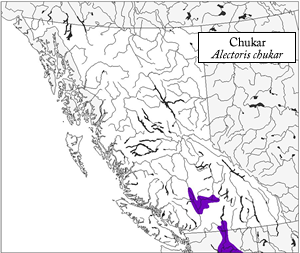This is a very distinctive species in British Columbia, and is unlikely to be misidentified. The rufous tail feathers, which can easily be seen on a bird that flushes away from the observer, are also shown by the Gray Partridge, which occurs alongside the Chukar in certain areas of the southern Okanagan Valley (e.g., Osoyoos, Richter Pass); however, the size (Chukar larger), facial pattern, overall colouration (browner in Gray Partridge, greyer in Chukar), and pattern of the sides and flanks differ significantly between these two species and should allow for easy identification of all but the most briefly observed individuals.
| The characteristic, far-carrying call of the Chukar is a raucous, cackling kakakaka-chuKAR-chuKAR-chuKAR that intensifies and becomes louder towards the end; the latter phrases are sometimes given with three syllables: chuKARaa. This call is usually given by an individual perched conspicuously on a rock outcrop or other prominent perch. It also gives similar raucous, cackling notes periodically while foraging or as a means of communicating among members of a covey. When flushed, members of a covey give a loud, harsh note followed by several softer notes: PITCH-oo-whidoo-whidoo; this call gradually subsides as the birds disappear. Source: Christensen (1996); Sibley (2000); Madge and McGowan (2002) |
Courtship
The raucous calling that is common in this species is primarily given for territory establishment and is not an important component of courtship. During courtship activities, the male approaches the female and engages in several postures, including head tilting while turning sideways to expose the barred flanks, and circling the female with the head tilted and the flanks exhibited (sometimes with the head bowed and the wings drooped). The male often pecks at the ground during courtship and, immediately prior to copulation, is joined by the female in this behaviour. Pairs form during the early spring (March-April); during drought years, only a certain percentage of the population will form pairs and the rest will remain in non-breeding coveys throughout the breeding season. This species is a monogamous breeder.
Nest
The nest is placed on the ground, usually under the shelter of a rock overhang, beneath shrubs such as sagebrush or antelopebrush, or (in more open habitats) beneath overhanging grasses. The nest itself is a shallow scrape (~20 cm wide and ~5 cm deep) that is sparsely lined with dry grasses, leaves, twigs, and occasionally a few feathers.
Eggs
A single clutch of (6) 10-15 (24) eggs is laid in April or May and is incubated primarily by the female (male may contribute some incubation) for 22-25 days before hatching. A second clutch is occasionally produced in June or July (exceptionally August) following the loss of the first clutch. In some cases, the female will lay two independent clutches that are simultaneously incubated by both parents. The smooth, glossy eggs are pale buff to brownish with fine reddish speckling (often quite dense). Eggs are present in B.C. between early April and late August.
Young
The young are downy and fully precocial upon hatching, and quickly leave the nest and are accompanied by the parents (primarily the female). The colouration of the chicks is creamy-white below (greyer on the breast) and buffy above, with bold parallel blackish streaks on the upperparts and fine blackish streaks on the rear flanks; the head is primarily creamy-buff to pale greyish-buff (browner and often finely dark-speckled on the crown and nape), with a narrow black line behind the eye. The bill is pale brownish and the legs and feet are dull yellowish. After they leave the nest, the young remain as a group accompanied by one or both parents for ~2 weeks, then merge with other family groups to form ‘nurseries’ that are tended by 1-2 females. The young are capable of short flights at only 7 days of age, and by 2 weeks of age they are capable of flying 10-20 metres. These large post-breeding coveys are retained throughout the winter and break up in the following spring as the breeding season commences. The young reach adult size by ~50 days of age. Chicks and partially-grown juvenal birds are present in B.C. between early May and late September.
Source: Cannings et al. (1987); Campbell et al. (1990b); Christensen (1996); Baicich and Harrison (1997); Madge and McGowan (2002).
|
The Chukar feeds almost exclusively on small seeds and green vegetation (grass, leaves), although it will consume small amounts of insects (ants, beetles, etc.) as well. In British Columbia, the fruits of the introduced Russian-olive tree are particularly favoured when they are available. Foraging occurs on the ground, and many of the seeds in the diet are obtained by scratching the top layer of soil to expose the buried seeds. Foraging activity is greatest in the morning and late afternoon. Coveys include only 4-10 individuals throughout most of the year, but post-breeding aggregations may include 30-50 (or more) birds, including numerous juveniles; this species also aggregates into larger coveys during harsh winter weather conditions as individuals congregate around available sources of food. Foraging coveys move continuously throughout their habitat, with the greatest levels of activity occurring in the morning and late afternoon.
Source: Cannings et al. (1987); Christensen (1996); Madge and McGowan (2002)
|
|

